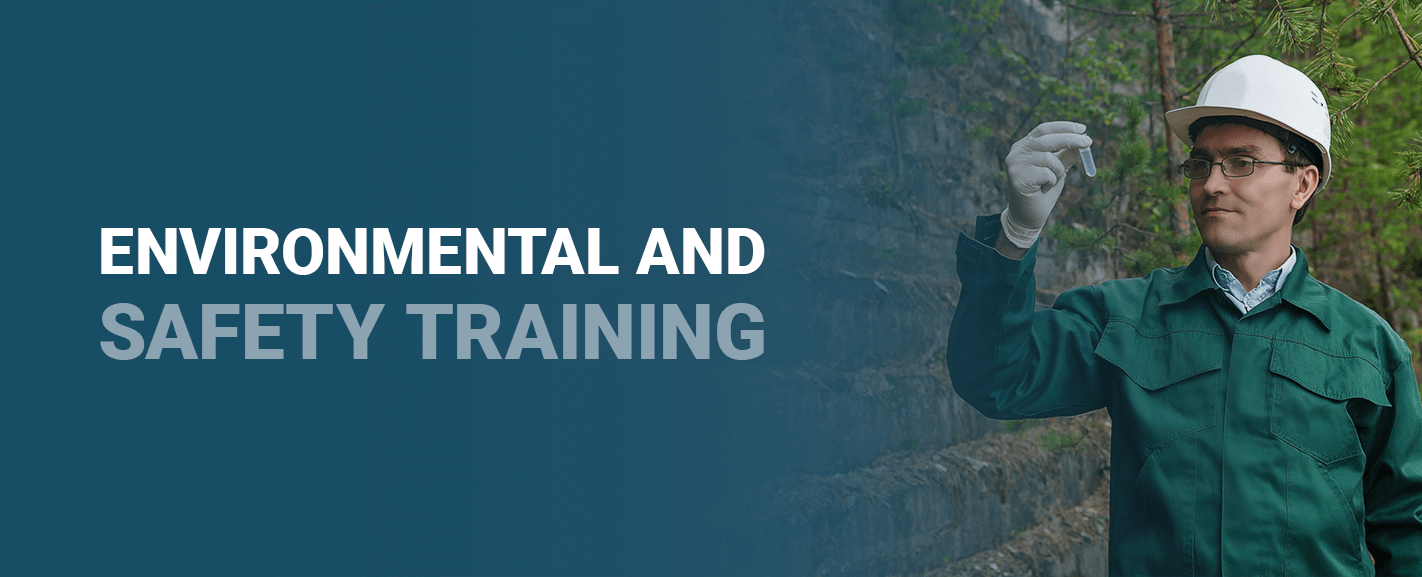Environmental Specialist Designations
These Specialist and Designations assure all employers or potential employers that the practitioner has exceptional acquired knowledge, skills, and abilities in the specified area. They are geared for the Environmental & Safety Managers who required training in EPA (40 CFR) requirements as well as other regulatory requirements for general industry, construction, oil & gas production, municipalities and federal government workplaces.
CEM
40 hoursCEM
40 hoursHTTTC
40 hoursHTTTC
40 hoursHTTTO
40 hoursHTTTO
40 hoursEHS
24 hoursENS
13 hoursENS
13 hoursHMS
13 hoursHMS
13 hoursSCS
13 hoursSCS
13 hoursHS
hoursHS
hoursHERA
4 hoursHERA
4 hoursHERO
8 hoursHERO
8 hoursHERI
12 hoursHERI
12 hoursHERR
4 hoursHERR
4 hoursEnvironmental Industry Safety Training

Most safety professionals also oversee environmental responsibilities at their facilities as well. Environmental courses provide industry professionals with valuable leadership skills when enacting preventive measures and responding to hazard situations. Whether the focus is on construction tasks — e.g., NPDES permits — or oil spill cleanup, taking a credentialing course is a productive way to stay up-to-date with the latest procedures.
As an environmental and safety professional interested in building reputable credentials, you can select from various courses to learn about applicable hazardous waste operations, air permitting, water permitting and other applicable regulations. Your certificate is obtainable independently of a college degree, allowing you to complete your training on a flexible schedule whether you’re starting your career or looking to advance. Learn more about our career-centered educational opportunities below.
Environmental, Health and Safety Training
The Occupational Safety and Health Administration (OSHA) recommends in Appendix C to 1910.120 of the official OSHA training manual that workers undergo compliance training to ensure their competence in abiding by environmental and safety regulations while on the job. This training must come from a qualified, knowledgeable trainer with the appropriate credentials. Pursuing training and certificates as a trainer shows employers that you are eligible to administer this training.
Completing an education program for a specialist role or another designation assures employers that you as the practitioner have acquired exceptional knowledge, skills and abilities in the specified area. The designations are intended for Environmental and Safety Managers who must train their staff in Environmental Protection Agency (EPA) 40 CFR and other regulatory requirements.

Environmental and Safety Training Courses
Available courses from the National Association of Safety Professionals (NASP) for environmental and safety range in specialties and cover OSHA regulations specific to the covered topics. NASP courses focus on making regulatory language more digestible, with instruction methods that make the content more enjoyable and memorable. The courses allow new professionals to gain competence and let experienced professionals refresh their working knowledge and advance to higher positions.
Certified Environmental Manager
The Certified Environmental Manager (CEM) course provides students with the knowledge and understanding to work independently while maintaining a professional knowledge of environmental compliance. Through this course, you will become an expert in managing ecological policies and procedures and learn to interpret and comply with EPA regulations and the Department of Transportation (DOT) Emergency Response Guide. Your employers or prospective employers will also appreciate the training on mitigating liability risks and reducing hazardous wastes common to job sites.
HAZWOPER Train-The-Trainer Classroom
The HAZWOPER Train-The-Trainer Classroom (HTTTC) course trains students in the proper Hazardous Waste Operations and Emergency Response standards in compliance with 29 CFR 1910.120. This course’s focus is to provide competency to trainers regarding the HAZWOPER standard. A portion of the course involves demonstrations and simulation exercises that students must perform in person to meet the experimental education requirements of the program.
Taking this course in a classroom setting lets you learn with an engaging instructor in the company of fellow safety professionals. The classroom HAZWOPER train-the-trainer course takes place over five days and is held in classrooms around the country. It is also available for groups of eight or more at your facility.
HAZWOPER Train-The-Trainer Online
The HAZWOPER Train-The-Trainer Online (HTTTO) course offers an online delivery format for Hazardous Waste Operations and Emergency Response standards — including valuable information about 29 CFR 1910.120. This course imparts supervisory knowledge and experience to trainers and covers topics you need to instruct effectively in your field. Although the course meets HAZWOPER training requirements, you should also seek in-person training to qualify for the experiential education requirements.
Environmental, Health and Safety Professional Certificate
The Environmental, Health and Safety Professional Certificate (EHS) course provides the opportunity for the student to obtain a Professional Certificate in Environmental, Health and Safety. After completing the course, you should thoroughly understand OSHA, EPA, DOT and other regulations. The course gives you information and resources related to workplace safety and your environmental protection responsibilities. Whether you are a recently employed safety or environmental manager or a professional who wants a refresher, this course is an invaluable learning opportunity that leads to a certificate of training.
Environmental Specialist
The Environmental Specialist (ENS) course provides a guided review of EPA and other environmental and safety regulations. Students learn how to manage hazardous wastes and navigate the processes for Spill Prevention, Control and Countermeasure (SPCC) and Stormwater Pollution Prevention (SWP3) Plans.
Hazardous Waste Management Specialist
The Hazardous Waste Management Specialist (HMS) course teaches students how to identify, manage and dispose of hazardous wastes. The training also provides a guided study of the relevant regulations and universal disposal requirements. Students will learn the steps for planning to engage with hazardous wastes and comply with restrictions and exemptions. Topics include volatile organic compounds (VOC) standards and waste minimization.
Spill Containment Specialist
The Spill Containment Specialist (SCS) course teaches professionals about HAZMAT spills, prevention regulations and other potential pollutants. Students will learn how to contain spills at their job site while complying with all regulations. Topics covered include the administrative procedures for oil storage (SPCC), chemical storage (ERP) and draining contaminated stormwater.
Environmental and Safety Compliance
Laws and safety regulations are in place to protect the health and overall wellbeing of the employees working at a job site. When your staff handles hazardous waste, these regulations are necessary and should be routinely followed for all environmental labor processes.
OSHA is the basis of these regulations. This agency of the Department of Labor controls safety guidelines applicable to each industry. Employers follow OSHA regulations to promote safe and efficient work environments for their employees. With an in-depth understanding of how to interpret OSHA regulations, you will successfully manage the regulations and requirements for each job while putting your team’s safety first.
The Importance of Environmental and Safety Training
Hazardous waste is any potentially harmful byproduct that might be carcinogenic, toxic or harmful to humans, animals and the planet. Some of the reasons employers must comply with the legal and professional standards of waste regulation include:
- Passing OSHA and EPA inspections: Businesses that abide by the appropriate regulations are more likely to pass an inspection and avoid incurring punitive action.
- Lowering expenses: Accidents usually cost more than prevention strategies. When employees carefully follow the necessary prevention procedures, fewer damages occur, reducing operational costs.
- Inspiring integrity: When businesses strive to keep the environment and their workers safe, public opinion improves. These companies can build a trustworthy reputation.
Purchase NASP’s Environmental and Safety Courses Online
NASP is dedicated to providing innovative training programs to help students retain key information about EHS and OSHA compliance. Sign up for a virtual environmental industry safety course from our online course catalog or reach out to us to learn more.







